Proc. of
Inactivation in situ of Polyphenol Oxidase in Ripe Avocado Fruit
Augusto Trejo-Gonzalez and Rosario Munguia-Mazariegos
Dept. Biotechnology, CIIDIR-IPN Michoacan,
Justo Sierra No. 28, Jiquilpan,
Marita Cantwell
Dept. Vegetable Crops,
Abstract. Heat treatment (30 to 80C water) of intact ripe avocado (cv. Hass) fruit was carried out for different periods of time. The objective was to achieve maximum reduction in polyphenol oxidase (PPO) activity without decreasing fruit quality. Heat treatments from 30 to 45C for 30 min reduced extractable PPO activity without having detrimental effects on peel color, pulp texture and flavor. The most effective treatment was 40C for 30 min which decreased extractable PPO activity by 65%. Heat treatment of intact fruit provides an alternative approach towards retarding browning of avocado pulp during processing. This study was carried out over a 2-year period with mature avocados from different harvest dates.
Several strategies have been used to conserve fresh avocado pulp, including refrigeration, freeze-drying (Gomez and Bates, 1970), oxygen exclusion (Lime, 1969), modified atmospheres (Hatton and Reeder, 1972), and stabilization in products such as guacamole and dips (Bates, 1970; Gomez and Bates, 1970). These treatments lengthen the storage life by retarding the discoloration reactions catalyzed by polyphenol oxidase (PPO) (Kahn, 1975; van Lelyveld et al., 1984). This enzyme catalyzes the conversion of monophenols to diphenols and the conversion of diphenols to quinones, which subsequently polymerize to form brown pigments (Vaughn and Duke, 1984).
The objective of this study was to determine whether mild thermal treatments of intact avocado fruits could decrease PPO activity and retard discoloration of the fresh pulp.
Materials and Methods
Mature fruits cv. Hass were
harvested from a commercial orchard in
Heat treatments were done by submerging the ripe fruit in water at temperatures from 30 to 50C for periods sufficient to raise the pulp temperature to that of the water bath. The temperature was monitored with a hypodermic needle-like thermocouple probe (0.724 mm. Omega BD 21) inserted into the stem end. After heat treatment, fruits were allowed to reach room temperature (20C) before removing the skin and seed. The pulp was homogenized in a Waring blender with cold acetone (-20C) in a 1:5 ratio (w/v) for 25 sec. The slurry was filtered in a Buchner funnel through Whatman #42 filter paper. This extraction procedure was repeated 5 times. After the last filtration, the acetone powder was dried under vacuum and the dried straw-colored powder was stored in a desiccator under vacuum at 4C (Dizik and Knapp, 1970).
PRO was extracted from the acetone powder by suspending 100 mg in a phosphate buffer (0.05 M, pH 6.8), centrifuging at 20,000 rpm for 5 min at 4C, and filtering the supernatant through 3 layers of cheesecloth. The enzymatic activity was determined on the filtrate using catechol as a substrate and following the formation of o-benzoquinone at 420 nm (Jen and Flurkey, 1979). The protein content of the enzymatic extract was measured both colorimetrically by the Biuret method at 540 nm and spectrophotometrically at 280 nm (Whitaker, 1972).
The crude enzyme preparation was purified by hydrophobic chromatography on a phenylsepharose CL-4B column, equilibrated with phosphate buffer (0.05 M, 1 M KCI, 1 M NH4S04, pH 6.8) and eluted with a gradient of ammonium sulfate (1 M to 0.1 M) (Flurkey and Jen, 1980). Every fraction of 2.5 ml was monitored for PPO activity and protein content.
Results and Discussion
Fruit development and ripening. Fruits were harvested from October to April and had an average fruit weight for all harvests of 220 g. Fruits continued to increase in length up to the December harvest. Regardless of the date of harvest, the time required for ripening mature fruits was 11 ±1 day. Weight loss of the fruit during ripening decreased from 0.9 to 0.5% per day for fruit harvested in October and March, respectively.
Ripe fruit composition. Table 1 shows the general composition of ripened fruits. Oil content varied from to 12.9 to 17.6% as the date of harvest advanced. Water content decreased as the fruits increased in oil content up to 16%, after which it remained constant at about 65.5%. Pulp pH declined continuously in fruits harvested over the 6 month period.
Specific activity of PPO from fruits harvested at different dates. The specific activity of PPO extracts from fruits harvested from October to March is shown in Figure 1. Protein (total nitrogen x 6.25) content remained relatively constant over this period, whereas specific activity was low in October, increased to a maximum in December, and then declined to intermediate levels.
Heat penetration curves. Figure 2 shows the internal temperature of avocados treated in water at 30 to 80C at 10C intervals. For treatments of 60C or lower, the internal temperature reached the treatment temperature after 30 minutes.
Effect of thermal treatments on peel color, texture and flavor. Treatment temperatures above 50C were notable in causing a change in ripe peel coloration. The usual dark-purple color changed first to a light green then finally to a dark green-brown color. These visual changes are due to thermal degradation of both anthocyanins and chlorophylls as shown in Figure 3. Preliminary sensory evaluation (data not shown) of heat treated avocadoes showed that fruit pulp treated above 50C lost consistency and developed off-flavors.
Effect of thermal treatments on enzymatic activity. The effect of thermal treatments on the enzyme activity of the acetone powders derived from December-harvested avocados treated for 30 minutes at 25 to 80C is shown in Table 2. PPO specific activity was reduced by all heat treatments. In the temperature range where external color, and pulp texture and flavor were not detrimentally affected, the greatest reduction in activity was observed in fruits treated in the range of 40 to 50C. Heat treatment of avocados from different harvest dates generally resulted in reduced specific activity of the extracted PPO in this same temperature range (Figure 4). The pulp of fruits halved after heat treatment also showed a much retarded rate of discoloration at 20C (documented by photographs).
PPO purification. The hydrophobic chromatographic elution pattern of
PPO from the acetone powder of untreated ripe avocado fruits is shown in Figure
5. PPO from fruits treated at 40C for 30 min showed a 65% reduction in specific
activity (Figure 6). Fruit treated at high temperature (80C) showed no
Comparison of PPO activity from in vitro and in situ heat treatments. Under the same treatment conditions, thermoinactivation of extracted PPO (in vitro heat treatment) was less than that observed in PPO extracted from heat-treated fruits (in situ heat treatment) (Table 3). A treatment of 40C for 30 min left only 40% of the original PPO activity, whereas 85% of the specific activity remained when the same heat treatment was applied in vitro.
Conclusions
The PPO activity extracted from ripe 'Hass' avocados varied over the harvest season from October to April, with the highest activity being observed in fruits harvested in December. In situ heat treatments of ripe fruits over the range of 35 to 45C for 30 min significantly reduced specific PPO activity. Hydrophobic chromatography was used to confirm the thermolability of PPO. Heat treatments did not decrease fruit quality (color, texture and flavor) until treatment temperatures surpassed 50C.
Literature Cited
A.O.A.C. 1976. Official methods of analysis., ed. W. Horwitz. Association of Official
Analytical Chemists,
Bates, P.R. 1970. Heat-induced off-flavor in avocado flesh. J. Food Sci. 35: 478-482
Dizik, K.R. and F.W. Knapp. 1970. Avocado polyphenol oxidase: purification and fractionation on Sephadex thin layers. J. Food Sci. 35: 282-285.
Flurkey, H.W. and J.J. Jen. 1980. Hydrophobic adsorption chromatography of peach polyphenol oxidase. J. Food Sci. 45: 1622-1624.
Gomez, F.R. and R.P. Bates. 1970. Storage deterioration of freeze dried avocado puree and guacamole. J. Food Sci. 35:472-475.
Hatton, T.T. and W.F. Reeder. 1972. Quality of 'Lula' avocados stored in controlled atmospheres with or without ethylene. J. Amer. Soc. Hort. Sci. 97(3): 339-341.
Jen, J.J. and W.H. Flurkey. 1979. Hydrophobic chromatography of peach fruit polyphenol oxidase. HortScience 14: 516-518.
Kahn, V. 1975. Polyphenol oxidase activity and browning of three avocado varieties. J. Sci. Food Agric. 26: 1319-1324.
Lime, B.J. 1969. Preparation and storage studies of freeze-dried avocado salad. Food Technology 23: 317-388.
Prabha, T.N., B. Ravindranath and
M.V. Patwardhan. 1980. Anthocyanins of avocado (Persea
van Lelyveld, L.J., C. Gerrish and R.A. Dixon. 1984. Enzyme activities and polyphenols related to mesocarp discoloration of avocado fruit. Phytochemistry 23: 1531-1534.
Vaughn, K.C. and S.O. Duke. 1984. Function of polyphenol oxidase in higher plants. Physiol. Plant. 60: 106-112.
Whitaker, J.R. 1972. Principles of enzymology
for the food sciences. Marcel
|
Table
1. The composition of ripe ‘Hass’ avocado fruits from 5 different harvests. |
||||
|
Date |
Weight z (g) |
Water y (%) |
Oil y (%) |
pH y |
|
October |
228 |
71.7 |
12.9 |
6.48 |
|
January |
224 |
68.1 |
14.5 |
6.38 |
|
February |
217 |
65.6 |
15.6 |
6.33 |
|
March |
214 |
65.4 |
17.6 |
6.29 |
|
April |
217 |
65.8 |
17.3 |
6.15 |
|
z Data are averages from 50 fruits. y
Data are averages from 3 replications of 4 fruits each. |
||||
|
Table 2.
Specific activity of PPO after extraction from avocado fruits treated
for 30 minutes at different temperatures.z |
|||
|
Treatment
Temperature (C) |
Specific Activityy Units/mg protein |
||
|
|
|
280 mm |
Biuret |
|
25 |
(Reference) |
7.6 |
54.1 |
|
30 |
|
7.3 |
48.0 |
|
35 |
|
5.4 |
24.0 |
|
40 |
|
4.0 |
16.1 |
|
45 |
|
3.6 |
21.9 |
|
50 |
|
3.9 |
18.9 |
|
55 |
|
5.6 |
28.4 |
|
60 |
|
3.7 |
26.2 |
|
65 |
|
4.7 |
28.0 |
|
70 |
|
5.5 |
35.8 |
|
75 |
|
6.0 |
51.4 |
|
80 |
|
4.6 |
22.9 |
|
z Three fruits from the December
harvest were treated at each temperature. A composite sample of 50 g pulp was
used to prepare the acetone powder. y Specific activity was calculated
on the basis of protein determination by absorption at 280 mm or by the Biuret colorimetric method. |
|||
|
Table 3. Reduction of PPO activity by 30 minute heat treatments to intact avocado fruits (in situ) or to acetone powders prepared from fruits (in vitro). |
||
|
|
% PPO activity z |
|
|
Treatment |
In vitro |
In situ |
|
25C |
100 |
100 |
|
40C |
85 |
41 |
|
80C |
2 |
13 |
|
z Activity measurement after purification by hydrophobic chromatography. |
||

Fig. 1. Initial PPO activity in ripe 'Hass' avocados.
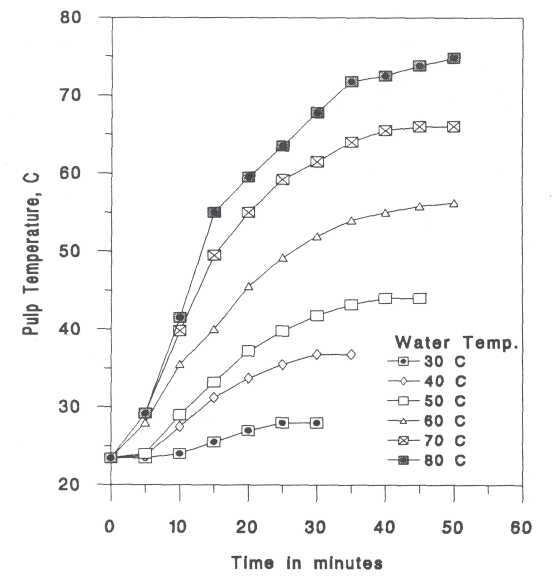
Fig. 2. Heat penetration curves for 'Hass' avocados treated
in water at different temperatures.
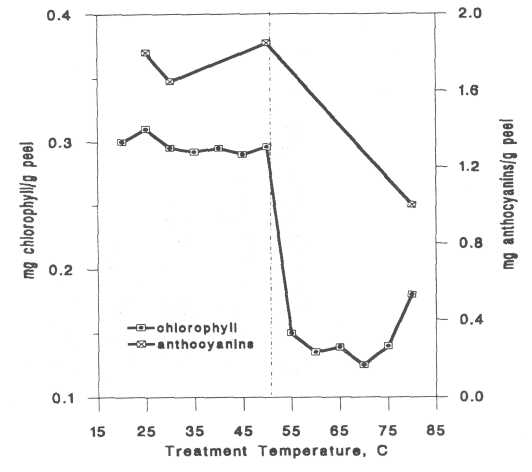
Fig. 3. Thermodegradation of
'Hass' avocado peel pigments.
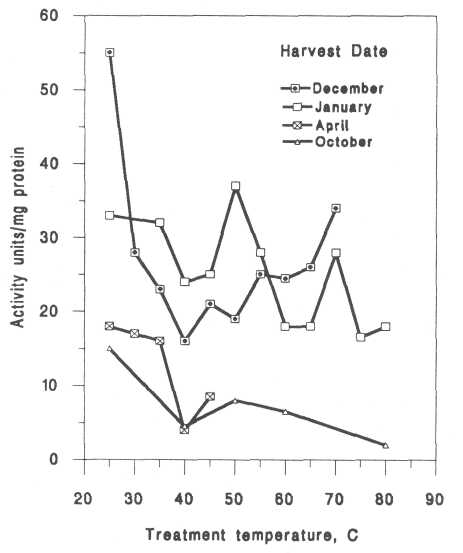
Fig. 4. Specific activity of PPO extracted from ripe 'Hass'
avocados harvested on different dates and subjected to different heat
treatments for 30 minutes.
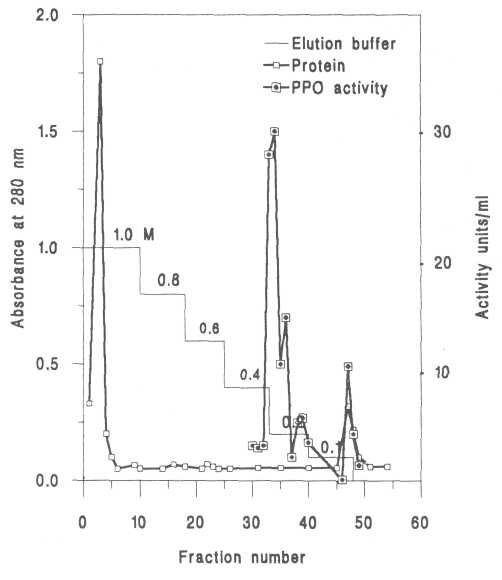
Figure 5. The hydrophobic chromatographic elution pattern of PRO from an acetone powder of untreated ripe 'Hass' avocado fruits.
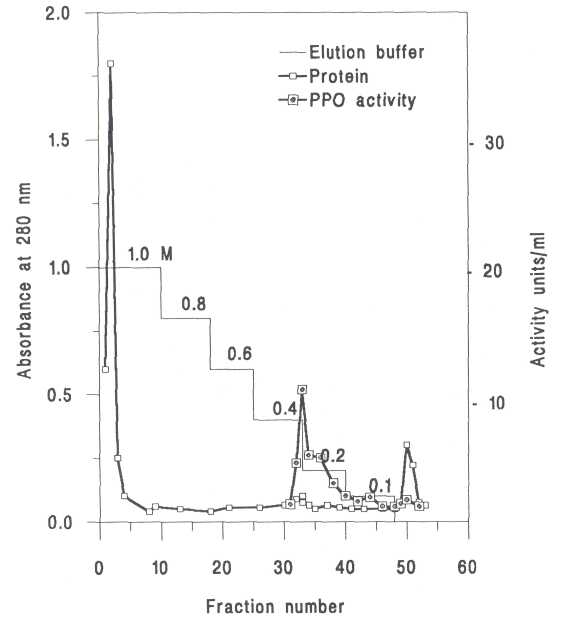
Fig. 6. The hydrophobic chromatographic elution pattern of
PPO from an acetone powder of ripe 'Hass' avocados treated with 40C for 30 min.
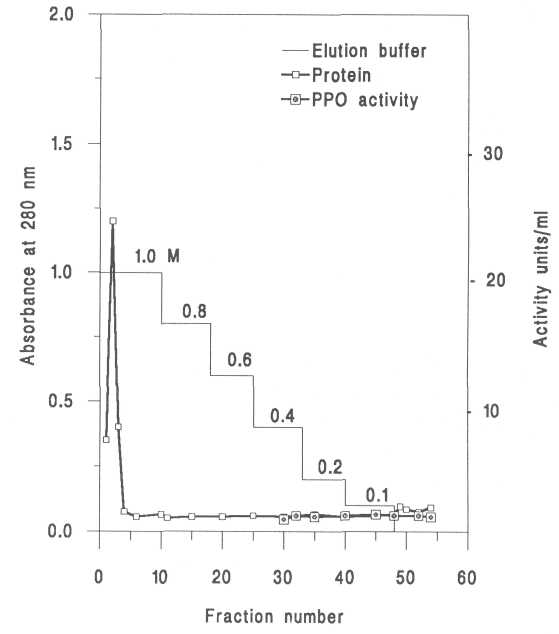
Fig. 7. The hydrophobic chromatographic elution pattern of PPO from an acetone powder of ripe 'Hass' avocados treated with 80C for 30 min.